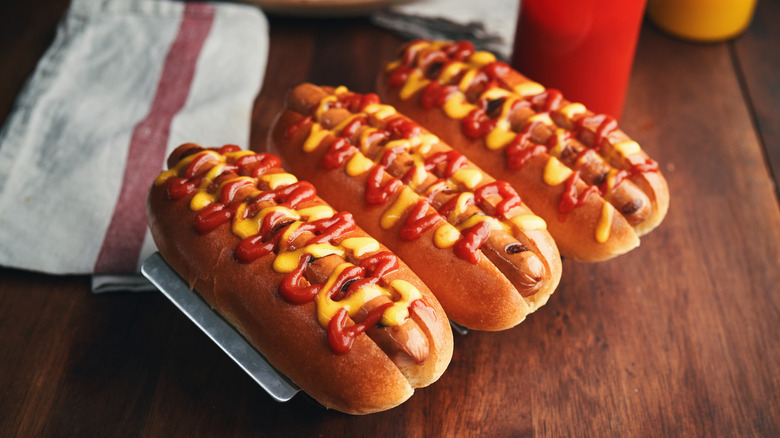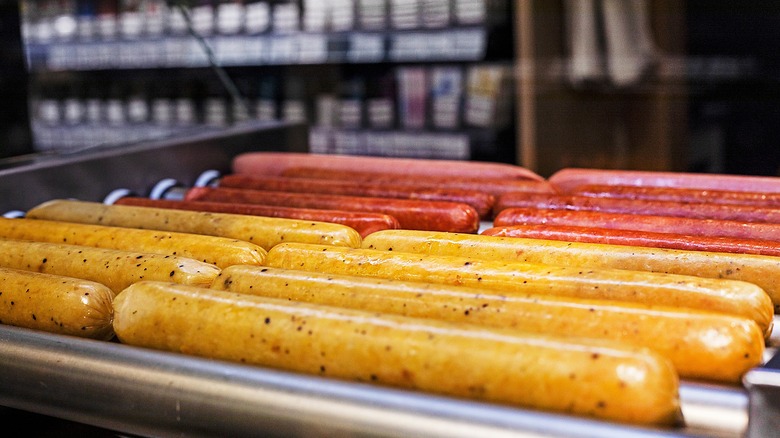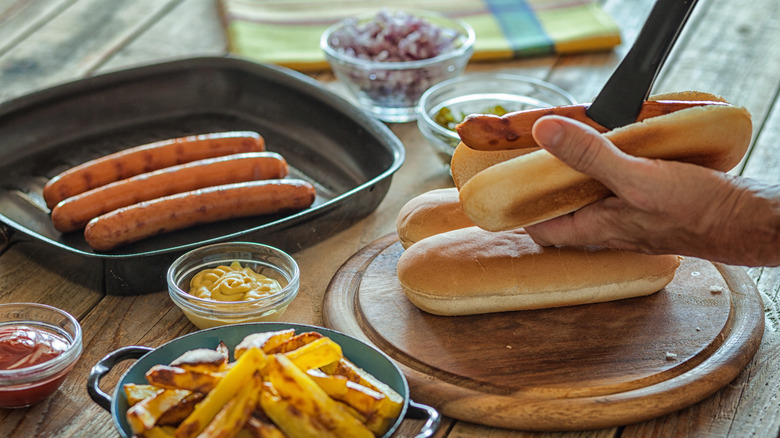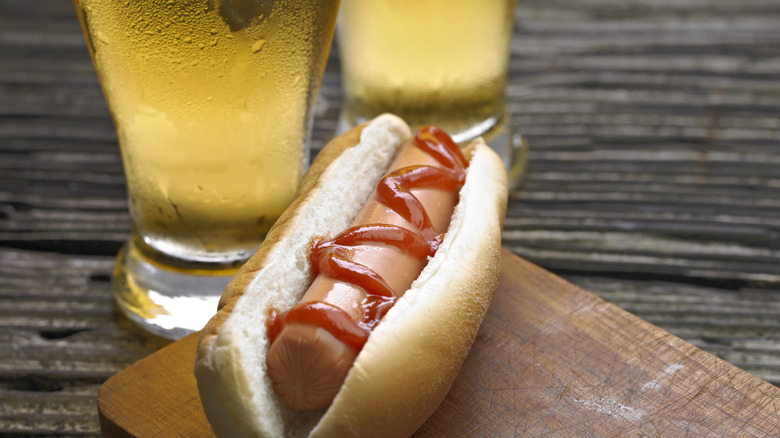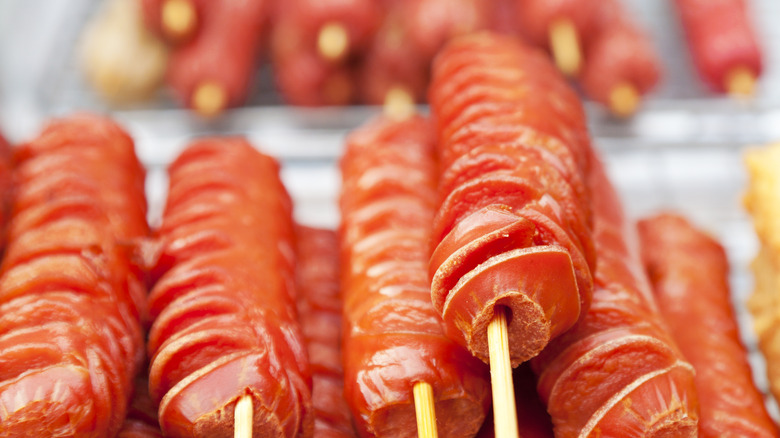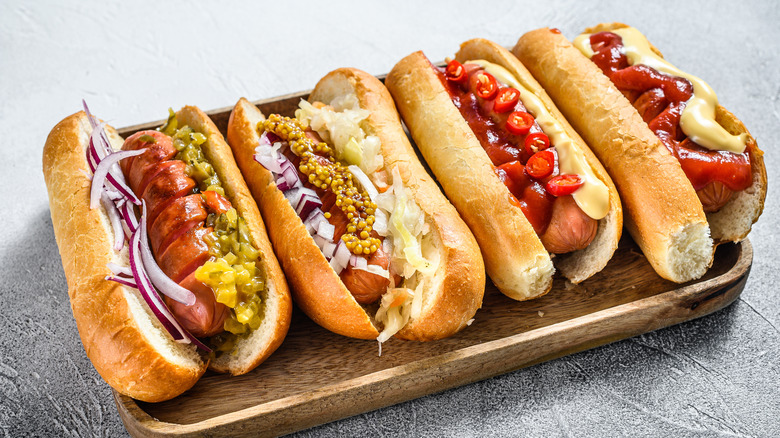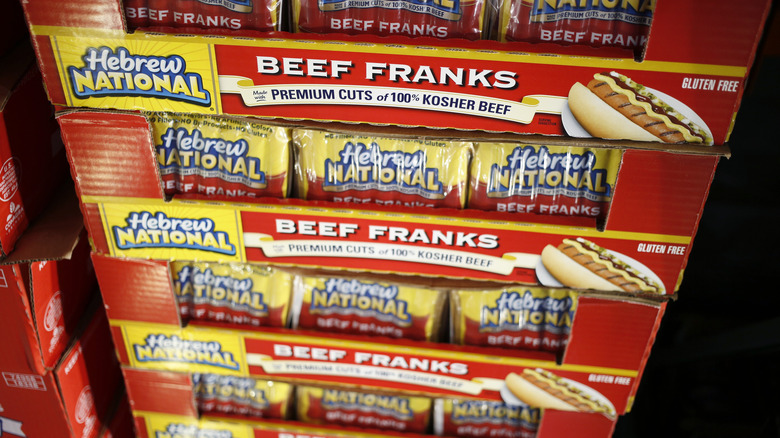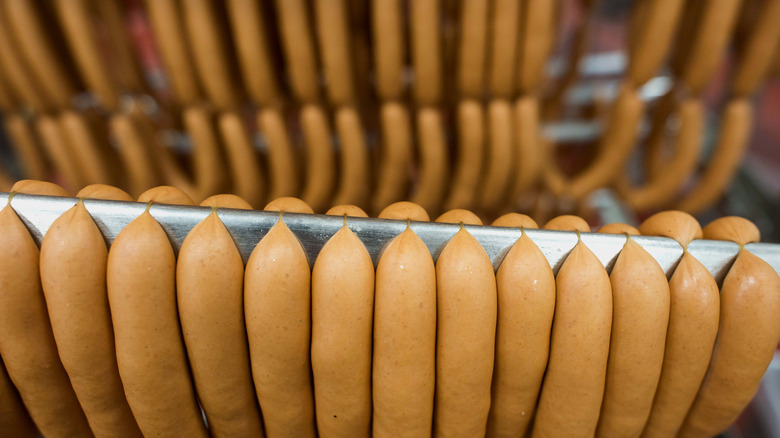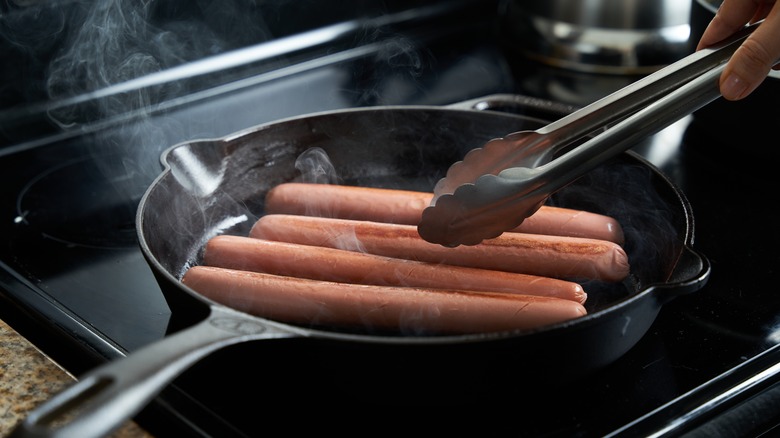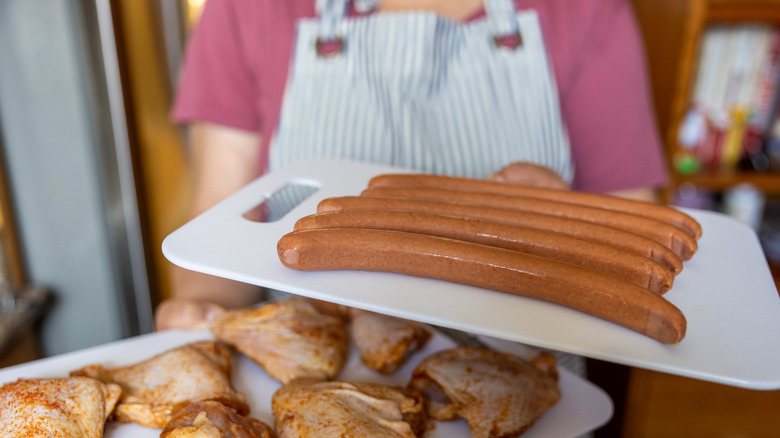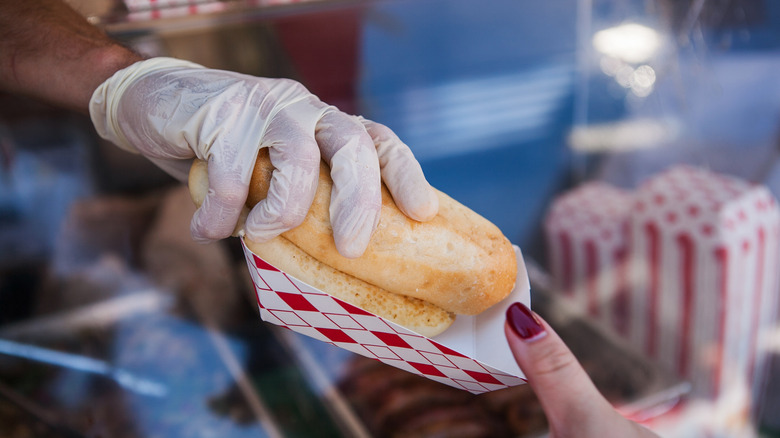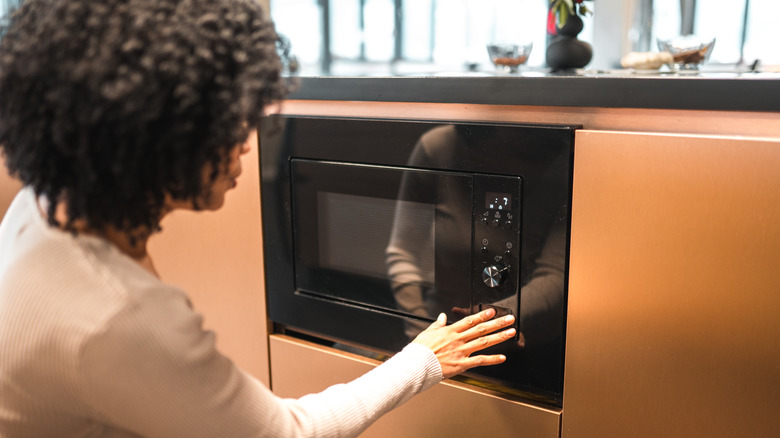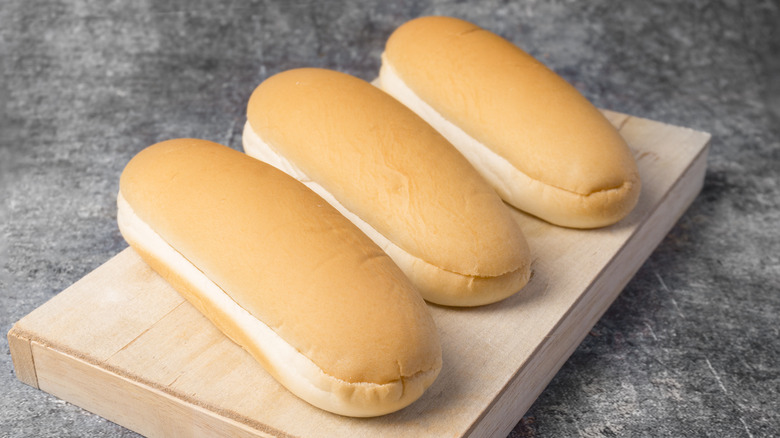Secrets To The Perfect Hot Dog Bite You'll Wish You Knew Sooner
Anyone who's eaten even just a few hot dogs over the course of their life will tell you that not all hot dogs are the same. Some are bland, sad, texture-less sausages shoved onto a soppy bun and served lukewarm and topping-less, while others are cooked to a perfect finish (whether you prefer your dog lightly grilled or charred to a crisp), with a snappy casing, juicy interior, fluffy and possibly toasted bun, and all the toppings you could want.
So how do you recreate the most perfect hot dog bite you've ever experienced in your life? No, you don't necessarily need to hunt down that wonderful dog you had at a random restaurant or sidewalk cart. And, no, you don't need to haul out the barbecue in the middle of winter. Instead, there are several methods and secrets for creating the perfect hot dog bite, and most are well within your reach. Here's what you need to know.
At-home rotisseries are a thing, and you can buy one for your hot dogs
Using a rotisserie is one of the best methods for cooking a hot dog and, yes, you can buy one for your home-cooking needs. No, we're not talking about those large rotisserie cabinets that you might see in your big-box grocery store that are used for cooking rotisserie chickens. Instead, think of the small, rotating rotisserie rollers that you might see in a gas station convenience store. Even if you don't like the idea of a gas station hot dog, no one can deny that the rotisserie method is a superior option when it comes to achieving a juicier hot dog that's not all dried out. It also ensures you have a hot dog that's entirely cooked to the same level of doneness all the way around.
You can buy a range of hot dog rotisseries online, whether you're looking for a gas station-grade setup or you just want something compact for the countertop. You can also buy rotisserie attachments for your grill. Whatever option you go with, though, if you love a good rolled, rotisserie hot dog, know that one is only a few clicks away.
If pan-frying, a preheated pan is key to crispy skin
It's just a fact (at least for some folks) that the perfect hot dog bite means a crispy exterior and a juicy interior. However, cooking your hot dog any ol' way won't get you that mix of textures. Grilling is often thought of as the go-to way to cook a hot dog to achieve that delicate balance between the outside and the inside. That said, grilling isn't always an option — which is why you might turn to pan-frying. If you do, Ball Park senior brand manager Michael Roslen says, "We'd recommend using a grill pan and cooking at a high heat to give similar results as an actual grill outside. This will give you the tasty sear and crisp grill marks everybody loves."
Additionally, make sure that the pan is warmed to that high heat before you place your hot dogs in the pan. You should also consider using a pan made from cast iron. Cast-iron pans hold high heat well, allowing you to quickly achieve that desirable sear and crispy exterior.
Beer can add extra flavor not just when braising, but when boiling, too
While general consensus may be that a perfect hot dog bite needs some char and grill marks, there are still those individuals out there who prefer the classic boiling or steaming method, no char to be seen. If that's you, though, don't think you have to settle for bland hot dogs. While, yes, visibly browning your hot dog taps into the Maillard reaction, a chemical response that's known for giving roasted foods their flavor, you can find flavor other ways as well.
For example, many may already know that you can braise your hot dogs in beer, which includes simmering your cooked dogs in beer for a few minutes after cooking but before serving. But did you know that you can boil your hot dogs in beer, too? Skip the water the next time you boil a hot dog and use beer instead (or you can also use beer for just part of the water you might normally use, instead of making a one-to-one swap). It's an easy way to add extra flavor to a boiled hot dog without taking the extra step of braising.
Cutting your hot dogs causes them to lose moisture; leaving them intact prevents bursting
Folks are fairly divided when it comes to scoring or butterflying your hot dogs versus leaving them intact. Some claim that if you score, split, or butterfly your hot dogs, you risk losing all of the moisture content and are just taking an unnecessary step that complicates your cooking process This camp believes that splitting your hot dogs is among the worst mistakes everyone makes when cooking them. Others, however, say that if you don't score, split, or butterfly your hot dogs, you can end up with frankfurters that burst, making them unsightly and causing the loss of moisture anyway; they note that butterflying is, in fact, a quick technique that improves your hot dogs because you'll be increasing the meat's surface area, allowing for more overall char.
Regardless of which camp you fall into, though, just realize that, for the perfect hot dog bite, this isn't something to worry about too much. Both sides come with pros and cons, so it's entirely up to personal preference. According to Ball Park's Michael Roslen, you can even look for hot dogs that offer the best of all worlds, no butterflying required. He said, "That's one of the best parts of Ball Park Franks — no need to score or butterfly them since they plump when cooked without having to take an extra step!"
If you do lose moisture, you can make up for it with the right toppings
If you do butterfly or otherwise cut or score your hot dogs and end up losing some of that fatty moisture, don't worry. No matter the reason your hot dog has dried out a bit, you can make up for it with the right toppings. Look for moisture-rich and/or high-fat toppings that will complement the hot dog's natural flavors.
One hot dog topping growing in popularity that might surprise you? Peanut butter. While you might not think of peanut butter as something that would add moisture to your dog, it's worth noting that, when added to a (literally hot) hot dog, the butter begins to melt, creating a fatty, smooth, nutty sauce. You can also grab overlooked hot dog toppings such as melted cheese, ranch dressing, or pesto. Flavor-forward and moisture-rich veggie-based toppings, such as slaws, kimchi, or even salsa, are also good picks. For a Greek-inspired dog, add a mixture of chopped cucumber and tomato along with feta and tzatziki.
Hot dogs with higher fat content cook better
If you want to create the perfect hot dog bite from the start, beginning with your trip to the grocery store, there's one thing you'll want to look for in the deli aisle when you're deciding which hot dogs to buy: a higher fat content. Typically, all-beef hot dogs have higher fat content than hot dogs made from pork, which means they're less likely to dry out and more likely to give you that desirable mixture of a snappy exterior and a moist interior when grilling or pan-frying.
Beyond just the better cooking, though, all-beef hot dogs (as well as hot dogs that are 100% of whatever meat they're made from) are considered healthier than hot dogs made from a combination of processed and mechanically separated meats. As registered dietician Jenna Stangland told HuffPost, "Processed meats may also have added nitrates, which, when combined with protein, can form a compound that has been linked to certain cancers. You want to look for a 100% meat (or veggie) hot dog that is not processed, cured or with added fillers."
Hot dogs made with intact casings give you that desirable snap
If you're a fan of hot dogs, you know about the "snap." It's that impossible-to-replicate feeling that occurs when you bite down on certain hot dogs — your teeth quickly cutting through the exterior that gives you just a slight bit of resistance — and the hot dog casing breaks, allowing all the interior juices to burst outward. If you want this snap in your perfect hot dog bite, there's another thing you need to look for when picking out hot dogs at the grocery store: intact sheep or hog casings.
The snap that comes from those intact casings is part of what makes Chicago-famed Portillo's hot dogs so delicious. The cult brand uses Vienna Beef hot dogs, a premium hot dog made with that desirable 100% beef and none of the funny business like artificial colors or fillers. Each dog comes with its casing intact, unlike some grocery store brands that remove the casings before the meats are packaged and shipped to stores.
Whatever your cooking method, oil keeps that casing intact
If you're after that characteristic snap of a hot dog with a natural casing, the last thing you want to happen is for that casing to snap while you're in the middle of cooking. In order to avoid this, there are a few things you can do.
First and foremost, make sure you're giving your hot dog some moisture; if you're not boiling your hot dogs, add a little oil to them when grilling, pan-frying, or using a rotisserie. A dry hot dog is more likely to split. Additionally, if you're grilling, don't toss your hot dogs right over the flames. While high heat is necessary for a nice char and grill marks, there is such a thing as too-high heat. Some recommend that you also poke a few small holes in the hot dog to allow steam to escape so that the natural casing doesn't burst. This is a nice middle ground between keeping the casing entirely intact and splitting it all the way down the middle or butterflying it, the latter of which is going to diminish the "snap" effect.
As with all meat, letting your dogs come to room temp helps them cook evenly
It's just a general rule that allowing your meat to come to room temperature before cooking results in a more even cook. Yes, letting your hot dog come to room temperature before cooking isn't as big a deal as letting a larger piece of meat come to room temperature before cooking (the bigger the meat, the longer it takes to cook to a safe internal temperature, and the more likely you are to overcook the exterior while you wait for a cold interior to come up to the right temperature). However, if you're going to be cooking your hot dogs at a very high heat, like on a grill or in a preheated cast iron pan, it can still help to start the meat at room temperature to ensure that your exterior isn't charred before your interior heats up.
You don't have to leave them out for long. A half an hour will work. For food safety purposes, according to the U.S. Department of Agriculture, you definitely shouldn't leave hot dogs out for more than two hours or more than one hour if the temperature is higher than 90 degrees Fahrenheit. This rule applies to both cooked and uncooked hot dogs.
Hot dog vendors use dirty water to help achieve better flavor
One seriously underrated secret to the perfect hot dog bite? Dirty water. Have you ever watched street vendors pull their hot dogs from a vat of suspiciously colored liquid before plopping it on your bun? That's dirty water — and, no, it's not actually dirty. While it may not look it, this cooking liquid is totally safe and filled with flavor, making it a method you might want to replicate at home.
Dirty water will contain different ingredients depending on where you buy your hot dog. Common flavorings include red pepper, cumin, vinegar, onion, nutmeg, tomato sauce, or ketchup. Hot dogs sit in this mixture for up to an hour. And if you're still not quite sold on this cooking method for your hot dogs, maybe just take it from one of the culinary greats. The late Anthony Bourdain, a celebrated chef, author, and travel documentarian, recommends the dirty water hot dog as one of the top things to eat when visiting New York City.
Hot dogs can make your microwave spark
While there are some things you'll specifically want to do or look for in order to achieve the perfect hot dog bite, there are also a few things you'll want to avoid in order to achieve the perfect hot dog bite.
One of the cooking methods that is not recommended for a perfect hot dog bite? Microwaving. However, we're not telling you to stay clear of the microwave when cooking up a batch of dogs because the end result will be subpar (that's another issue). Instead, we're telling you to stay away from the microwave because hot dogs can actually make your microwave spark (the phenomenon may also occur when heating up carrots, peppers, and green beans). The U.S. Department of Agriculture notes that this is due to the unique mixtures of salt and additives in hot dogs. If this so-called arcing occurs, be sure to stop your microwave immediately and use a different cooking method, the federal agency advises.
You can steam your buns in the same pot that you cook your hot dogs in
One thing that can really upgrade your next hot dog? Giving the bun a little attention. A steamed or toasted bun really takes your hot dog bite to the next level. However, if you don't want to spend extra time on this added chore, there's good news: You can steam your hot dog buns in the same pot that you cook your hot dogs in if you're boiling or braising them. Just use a steamer basket, and steam the buns while the hot dogs simmer.
Prefer your hot dog buns to be a little toasty and textured rather than fluffy and soft? Ball Park's Michael Roslen suggests an approach that's not uncommon when making a grilled cheese sandwich. He recommends home cooks "lightly spread [the hot dog bun] with your favorite mayonnaise and toast opening side-down on the grill." When making a grilled cheese with mayo, the mayonnaise adds flavor to the bread and channels the Maillard reaction to change the chemical makeup of the bread's exterior for a crispier finish. The condiment will do the same for your hot dog bun.
